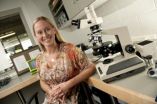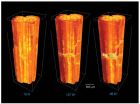(Press-News.org) "Some of the most pressing occupational health hazard risks in construction" are associated with masonry operations, asphalt roofing, and welding, wrote Deborah Young-Corbett in an article recently accepted by the Journal of Civil Engineering and Management.
To reduce these health risks to construction workers, Young-Corbett, an assistant professor of civil and environmental engineering at Virginia Tech and a member of the university's Myers-Lawson School of Construction since 2007, has studied much of the existing literature, identifying numerous gaps or problems in current construction practices.
As a result, Young-Corbett is working in a new field of engineering known as Prevention through Design or PtD. The optimal method of preventing occupational illnesses, injuries, and fatalities is to "design out" the hazards and risks; thereby, eliminating the need to control them during work operations, Young-Corbett said. This approach involves the design of tools, equipment, systems, work processes, and facilities in order to reduce, or eliminate, occupational hazards and environmental risks.
She is teaching these new state-of-the-art design tactics in her classes, providing her undergraduate and graduate students with a better understanding of how to improve the long-term success of the construction industry. Young-Corbett is a certified industrial hygienist, safety professional, and hazardous materials manager with a background in environmental sciences, human factors engineering, and industrial engineering.
In 2008, the National Institute for Occupational Safety and Health (NIOSH) launched the PtD initiative in an attempt to mitigate hazards in the construction sector in the design stage. Yet, four years later, Young-Corbett's review of the industry's safety procedures shows some of the "barriers" to PtD adoption and she identifies strategies for the construction industry to use to improve its health records.
Young-Corbett provides evidence in her assessment of the industry of a "gap" in the PtD initiative that does not address the approaches to "occupational health hazard control," with the key word being "health." These "health risks arise when workers are exposed to chemical, biological, or energetic hazards that might lead to various illnesses or fatalities," Young-Corbett said.
For example, additional changes in tool selection in masonry could alleviate much of the health risks, according to Young-Corbett. With a masonry operation, a key issue is to reduce the silica dust produced when sawing. Now that wet methods are available for hand-operated grinders used for surface finishing and cutting slots, these devices can keep operators' exposures to silica below Occupational Safety and Health Administration (OSHA) limits, she noted.
Construction supervisors should also be advocating hand operated surface grinders that are made with better vacuum dust collection systems, also reducing an operator's exposure to silica.
In roofing, the workers' exposure to asphalt fumes and vapors lead to both acute and chronic effects. Lung cancer is at an elevated risk for asphalt roofers. But, as Young-Corbett argued in her paper, delivery of hot asphalt to a job site via a tanker, eliminates the on-site kettle operation for handling and heating the asphalt, and makes a difference to the health of the worker.
Similar relatively simple changes in the practice of welding can also make an impact in the decline of health-related problems. The use of local exhaust ventilation systems can prevent worker exposure to metal fumes during welding, Young-Corbett wrote in her article in the Journal of Civil Engineering and Management.
In general, Young-Corbett said there are still needs for designs for better tools or materials, but in other cases, "effective tools exist but are not widely adopted within the industry…there is a need to elucidate the barriers to PtD adoption and to identify strategies for improved diffusion within the construction industry."
"The further refinement and marketing of PtD solutions such as the smokeless welding gun, the low-smoke welding wire, and the local-exhaust ventilation systems for welding are needed," she asserted.
INFORMATION:
Several of the research endeavors of Young-Corbett's laboratory have been in the realm of PtD. A NIOSH-sponsored research project entitled Dust-control Usage: Strategic Technology Intervention (DUSTI), developed new equipment design solutions for dust control in construction and an intervention for improving adoption rates within the industry. In a project sponsored by the National Science Foundation, a pervasive computing system was developed for sensing construction worker exposure to carbon monoxide and wirelessly summoning assistance in the event of over-exposure. Young-Corbett recently received a grant from NIOSH to develop PtD design and intervention strategies for health hazard control in masonry, asphalt roofing, and welding trades.
Prevention through design: A new approach to reduce construction risks
2012-12-10
ELSE PRESS RELEASES FROM THIS DATE:
Earphones, music players on kids' holiday gift lists? Add a hearing screening
2012-12-10
ANN ARBOR, Mich. – Just yelling "turn it down" isn't enough when young people are blasting music directly into their ears via earbuds and headphones, parents say. A new poll from the University of Michigan shows parents are strongly in favor of required hearing screenings for kids all the way up to age 17.
The University of Michigan Mott Children's Hospital National Poll on Children's Health recently asked a nationwide sample of parents of children 0-17 years old about whether they'd support requirements for hearing screening and where they'd prefer to have the screening ...
Internet use can reduce fatalistic view of cancer
2012-12-10
Washington, DC (December 10, 2012) – Many Americans have fatalistic views on cancer prevention—they believe that getting cancer is a matter of luck or fate. Recent research, published in the Journal of Communication, found that people who use the internet to inquire about their health are more likely to have a positive outlook on cancer prevention and diagnosis.
Chul-joo Lee, University of Illinois at Urbana-Champaign, Jeff Niederdeppe, Cornell University, and Derek Freres, University of Pennsylvania, published in the Journal of Communication their findings from a nationally ...
Patients' health service use
2012-12-10
Primary care physicians Johannes Hauswaldt, Eva Hummers-Pradier, and Ulrike Junius-Walker address the question of how frequently different patient groups attend doctor's appointments in this issue of Deutsches Ärzteblatt International (Dtsch Arztebl Int 2012; 109[47]: 814–20).
Current estimates for Germany are of 18 doctor's appointments per patient per year. However, until now there has been no further information on, for example, age groups or whether frequent contact with doctors is particularly noticeable in particular patient groups.
The authors defined patient ...
The greatest medical resource you've never heard of: Rochester epidemiology project
2012-12-10
ROCHESTER, Minn. -- It's the medical resource behind discoveries that have affected patients around the globe, treasured by researchers and funded by the National Institutes of Health for nearly 50 years: the Rochester Epidemiology Project. This comprehensive medical records pool makes Olmsted County, Minn., one of the few places in the world where scientists can study virtually an entire geographic population to identify trends in disease, evaluate treatments and find factors that put people at risk for illness — or protect them. And, as it nears the half-century mark, ...
Researchers reveal structure of carbon's 'Hoyle state'
2012-12-10
A North Carolina State University researcher has taken a "snapshot" of the way particles combine to form carbon-12, the element that makes all life on Earth possible. And the picture looks like a bent arm.
Carbon-12 can only exist when three alpha particles, or helium-4 nuclei, combine in a very specific way. This combination is known as the Hoyle state. NC State physicist Dean Lee and German colleagues Evgeny Epelbaum, Hermann Krebs and Ulf-G. Meissner had previously confirmed the existence of the Hoyle state using a numerical lattice that allowed the researchers to ...
Detecting tunnels using seismic waves not as simple as it sounds
2012-12-10
ALBUQUERQUE, N.M. — You'd think it would be easy to use seismic waves to find tunnels dug by smugglers of drugs, weapons or people.
You'd be wrong.
Nedra Bonal of Sandia's geophysics and atmospheric sciences organization is nearing the end of a two-year study, "Improving Shallow Tunnel Detection From Surface Seismic Methods," aimed at getting a better look at the ground around tunnels and learning why seismic data finds some tunnels but not others.
Her eventual goal is to come up with a seismic detection process for the border and other areas where tunnels pose ...
Alcohol pricing policies save lives and increase profits, experts say
2012-12-10
For immediate release – Dec. 10, 2012 (Toronto) – Setting minimum prices for alcohol increases health and economic benefits, say international experts, who met today for a seminar on alcohol pricing and public health.
The meeting — sponsored by the Centre for Addiction and Mental Health (CAMH), the Centre for Addictions Research of British Columbia (CARBC) and the Canadian Centre on Substance Abuse (CCSA) — focused on new analyses on Ontario and other provinces where minimum pricing policies have been implemented for a number of years.
Alcohol costs the Canadian economy ...
The chemistry of early photographs: New American Chemical Society video
2012-12-10
WASHINGTON, Dec. 10, 2012 — The chemistry of early photography comes under the lens in a new episode of Bytesize Science, the American Chemical Society (ACS) award-winning video series. Produced by the ACS Office of Public Affairs, it is available at www.BytesizeScience.com.
The video, which features Art Kaplan, of the Getty Conservation Institute, explains that the history of photography is rich with chemical innovations and insights. Early photographers came up with hundreds of different processes to develop images in unique and often beautiful ways. Kaplan describes ...
Space-age ceramics get their toughest test
2012-12-10
Advanced ceramic composites can withstand the ultrahigh operational temperatures projected for hypersonic jet and next generation gas turbine engines, but real-time analysis of the mechanical properties of these space-age materials at ultrahigh temperatures has been a challenge – until now. Researchers with the U.S. Department of Energy (DOE)'s Lawrence Berkeley National Laboratory (Berkeley Lab) have developed the first testing facility that enables CT-scanning of ceramic composites under controlled loads at ultrahigh temperatures and in real-time.
Working at Berkeley ...
Study identifies potential new pathway for drug development
2012-12-10
A newly found understanding of receptor signaling may have revealed a better way to design drugs. A study from Nationwide Children's Hospital suggests that a newly identified group of proteins, alpha arrestins, may play a role in cell signaling that is crucial to new drug development. The study appears in PLOS ONE.
More than one-third of drugs on the market work by targeting G protein-coupled receptors that control how cells communicate and function. With many hundreds of members, G protein-coupled receptors are the largest family of signaling receptors throughout the ...


